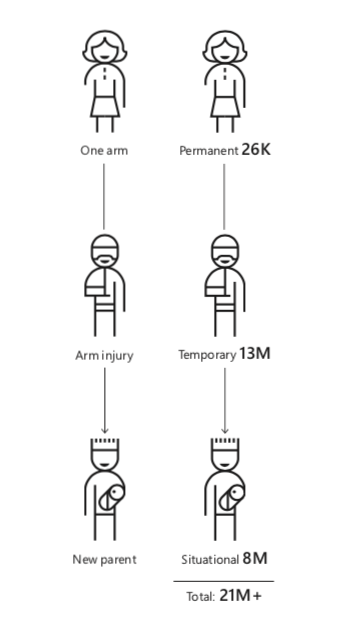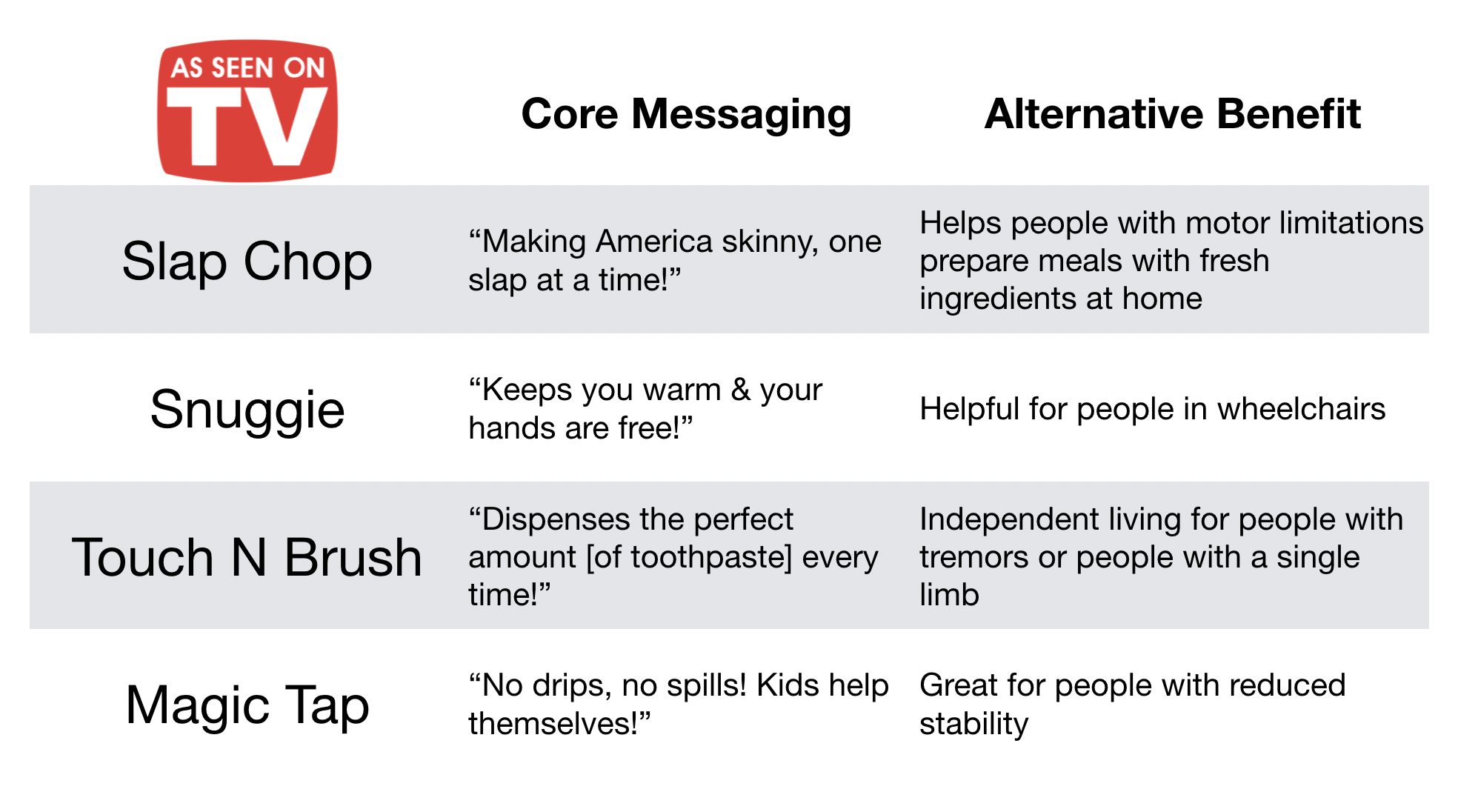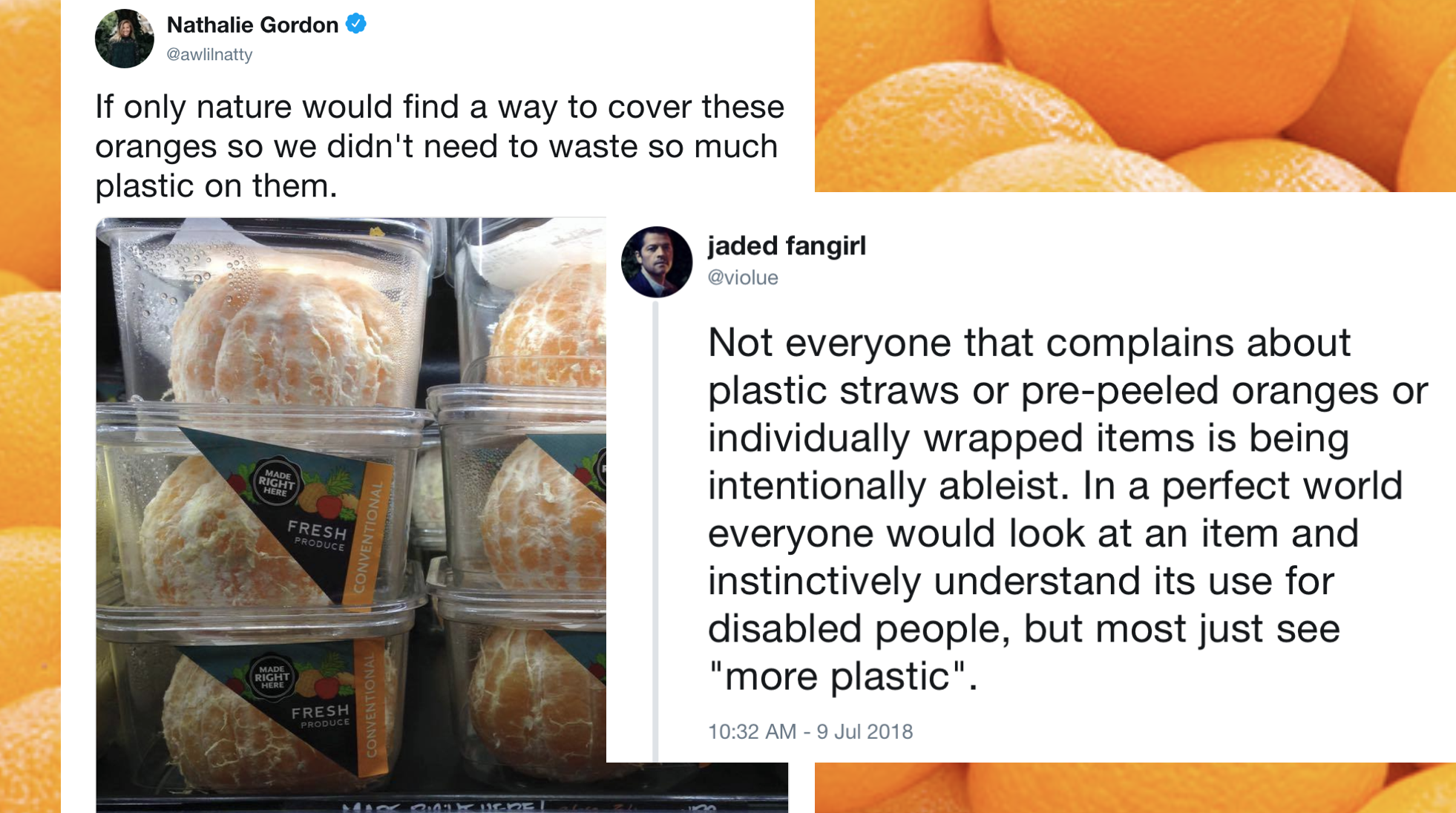The theme of 2019 Monki Gras was accessible craft. I spoke about building business cases for accessibility, or – to put it in a clickbait-friendly format – Aristotle and Infomercials.
Accessibility as a Business Priority
The Monki Gras presenters explored how a variety of perspectives and experiences can impact how users engage with a product. Accessible design considerations can include (but are definitely not limited to) things ranging from physical ability, age, gender, language, geographic location, neurodiversity, and chronic illness.
Ableism takes a narrow view that these conditions are “defects rather than dimensions of difference.” On the other hand, the social model of disability focuses on the interaction of people and their environment; if we focus on removing environmental and societal barriers, we can make holistically better products by addressing wider target markets and providing deeper value for users.
Target Market
Microsoft’s inclusive design kit (pdf) presents a persona spectrum, reflecting that when we make considerations for people with a permanent condition, we can also reach audiences that have temporary or situational constraints. This means accessible design can vastly expand the market we reach.

Source: Microsoft (pdf)
A canonical example of this is the “curb cut” effect. We had a whole excellent talk about the topic from Alex Chan if you’d like to know more.
Consumer Value
The other thing to consider when creating business cases for accessibility is that products can have disparate impacts on different subsets of the population.
A great example of this are the products sold in infomercials. These products are often dismissed as being frivolous, but they can be hugely impactful to a segment of the market. Even if something was designed to be a tool of convenience for a broad population, it can have huge positive externalities like utility, independence, and dignity for a subset of that audience.
So when we think about measuring impact of our products, remember a product may provide a small convenience for some while it provides significantly more value for others.
But What About Externalities?
While broader markets and deeper customer value are good things, there are also sometimes externalities. In the business world we are most familiar with tradeoffs like money or time, but it can be more difficult to sort through ethical considerations. Sometimes accessible product design means weighing competing sets of values.
For example, what if we care about making products accessible and we also care about environmentalism? While it is good to be environmentally conscious about plastic waste, it’s also worth noting things like pre-peeled oranges and plastic straws can help people with physical limitations have easier access to food and drinks.
Or what are our obligations when we operate across global communities? The recent example of Slack complying with American sanctions against Iran raised issues for companies and communities that suddenly lost access to their Iranian user base.
- What happens when parts of your software supply chain are bound by different legal obligations than you?
- What are your obligations to abide by other territories’ legal requirements, particularly when it adversely impacts your community?
- If you’re working in open source or an open core company, what are your obligations to reach impacted members of the community through alternative channels even though that may mean significant operational and overhead burden for you?
Ethical Frameworks for Business Cases
For most people in most situations, the larger struggle is not whether or not to be ethical, but rather it’s how to be ethical. Here are some practices you can start incorporating into your product management decisions.
Inclusivity Starts With Who You are Involving in Your Discussions
Involve a wider range of voices, particularly from impacted communities. Incorporate the perspective of various departments outside of product and engineering (what are your legal obligations? does this have a PR impact you should be considering?) Do you need external perspective from customers, suppliers, or partners?
In an industry that tends to bias towards action, this can sound like dreadful advice. More open communication does mean taking time to consider other perspectives, but it also doesn’t mean you must live in a world of constant bike-shedding meetings.
Consider the RACI model to help you involve more voices in a constructive manner. Who needs to be:
- R: responsible?
- A: accountable?
- C: consulted?
- I: informed?
Be more conscientious about who needs to be involved in a decision, what capacity they need to be engaged in the discussion, and when you need to involve them.
Include Accessibility in Your Risk Assessment
Have you incorporated inclusivity and accessibility into your risk assessment frameworks? Incorporate things like market reach, impact, and externalities into your frameworks.
Consider not only the cost of action but also the cost of inaction. What are you losing out on by not creating accessible product design? Who is losing out? How large is the impact?
What Does Ethical Behavior Looks Like in Your Organization?
It’s also helpful to have some basic ethical frameworks to apply to your decisions. Different ethical lenses prioritize different things. You don’t need to be an expert and you don’t need to dive into thousands of years of philosophical theory to lead these discussions. Instead, focus on these core questions:
- Are we being responsible?
- Are our choices good for everyone?
- Are we being fair?
- Are we making virtuous choices?
Here are some exploratory ideas to help get you started.
I also highly recommend the book Defining Moments by Joseph Badaracco if you want to dive into a deeper exploration of ethical conflicts in business settings.
Mission and Values
Finally, at an organizational level, we need to provide guidance and clarity. Using Google as an example: their mission statement “don’t be evil” does not provide much in the way of direction when people are weighing sets of competing values, but a document like “ten things we know to be true” can provide employees much more clarity about how the organization thinks about its values.
Articulate your organizational values and why you hold them. Discuss how your values balance and complement each other.
For example, if your engineering org values “velocity in shipping,” you probably also have some kind of value around “quality” along side it. If we prioritize only speed, our product may suck but ‘hey! at least we shipped!’; if we prioritize only quality, we can agonize over features and technical debt avoidance and never deliver a product to customers. It is when velocity and quality work in concert that you can deliver great products.
Think about how this applies to broader organizational values. Corporate values seem to commonly center around these areas:
- customer-focus: phrases like “delivering excellence”, “driving results” or “delighting the customer” are common examples
- team: this often takes the form of “we hire the best” or “we invest in employee development”
- communication: “open”, “transparent” and “collaborative” are frequently used for this topic
- innovation: look for phrases like “driving markets”, “bias towards action” or “curious”
- integrity: “responsible”, “trustworthy” or “positive community impact” are common examples
That is by far not exhaustive, but hopefully will give us a shared language to explore the how values balance each other.
- how does “driving results” balance with “we invest in employee development” (especially when times are hard)?
- does “open communication” impact different groups of employees differently?
- what happens when “driving markets” and “positive community impact” are at odds?
- how are we making sure we don’t apply unintentional bias to “hire and develop the best”? is our process actually fair and transparent?
Conclusion
You can build cases for inclusive and accessible design both morally and operationally. Accessible design has the opportunity to reach wide markets and have deep impact, but it also sometimes comes with other considerations.
Have an organizational framework on how to make these decisions. Be intentional about who you include in the conversation and about how you measure the risks and rewards of accessibility (and inaction.) Have a framework for transparent discussion around ethical dialogs and organizational values.



No Comments